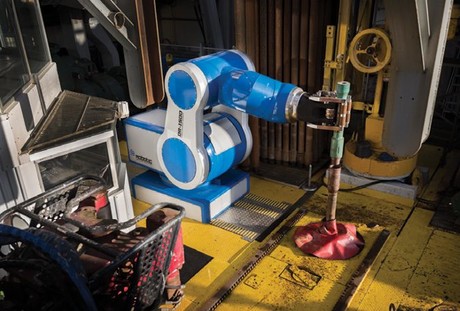Robotic oil drilling system improves efficiency and safety for offshore drilling

Robotic Drilling Systems AS (RDS) of Stavanger, Norway, and Siemens have teamed up to develop a drill floor solution comprising robotic technology for fully unmanned oil and gas operations. The system is designed to reduce offshore drilling costs and improve health and safety.
Health, safety, security and environmental concerns are major aspects driving oil and gas drilling companies worldwide. They need to comply with environmental legislation, but they are also focused on improving the safety of workers in the field while ensuring reliable platform operation.
Because global energy markets are characterised by increasing demands and currently decreasing profits, drilling companies are also challenged with reducing the overall costs of their operations. Offshore drilling requires a highly qualified workforce and includes high operating expenses.
Another factor is the time needed until first gas or oil. The shorter this time, the more profitable the drilling project. This means that companies are interested in increasing the efficiency of their operations by improving the reliability and availability of the hardware used.
As the automotive industry has demonstrated, replacing manual work by handling robots is not only a step towards lower operating costs, but also it leads to a higher level of quality and repeatability.
The system developed by RDS and Siemens is designed to automate the complete drilling process. It handles the pipes and tools required, and can be integrated into new or existing onshore and offshore installations.
The system consists of drill floor robots, robotic roughnecks, multi-size elevators and robotic pipe handlers. It is designed to remove high-risk manual tasks from the platform, while adding a new level of speed, accuracy and reliability to drilling operations.
“The RDS solution enables oil and gas operators to decrease rig time per well, reduce health, safety and environmental incidents, while reducing operating costs through consistent operations,” said RDS COO Jimmy Bostrøm. “Additionally, the system offers benefits, such as faster installation, along with lower noise and energy consumption.”
The technology not only reduces the personnel costs associated with the rig, it also redefines the role of the drilling crew. The focus will change from drill floor tasks to the well construction process.
Handling robots require intelligent motion control and a complex automation system to seamlessly work together to handle a complete work process without human intervention. Siemens provided RDS not only with a wide range of drives and the complete automation and communication system, but also with ongoing consulting and technical support.
Each of the robots is equipped with its own digital control system accommodated in a control cabinet. Simatic IPCs with Simatic Step 7 software interpret sensor signals, translate process commands into motion control sequences and coordinate the interaction of related robots. They provide the digital intelligence required for handling pipes, positioning and attaching tools, and drilling.
At the machine level, Siemens drives are combined with Sinamics 120 frequency converters, Simatic S7-300 controllers and Simatic ET 200 distributed I/O systems. They form a decentralised machine control system that links all the mechanical processes on the drill floor to the digital world. In the control room, WinCC Advanced is used to visualise all the processes via Simatic HMI panels, and allows especially trained technicians to monitor and control drilling without manual intervention.
The communication between the control room and the robots and between the robots themselves is established using industrial Ethernet communication via a range of Siemens switching technologies.
This explains why industrial communication is a key enabler of digitalisation in the oil and gas industry, as it is necessary to ensure a reliable, secure and continuous data transmission along the complete drilling value chain.
Early studies indicate potential savings of up to 40 rig days per year per rig with the RDS system. Beyond decreasing rig time, improving HSE and reducing operating costs, a full robotic system provides other benefits, such as less downtime, faster installation, lower noise and energy consumption, and reduced CO2 emissions.
The system replaces labour-intensive, costly and potentially dangerous manual processes using handling robots that seamlessly interact with one another. This not only reduces costs while improving reliability, equipment availability and environment protection, it also paves the way for oil and gas operations to evolve.
Robot-based drilling operations will generate a wealth of process data that can be used to better understand and optimise the drilling process.
“We anticipate an industry-wide convergence of automation and robotics by 2020,” said Bostrøm. “Automatic drilling and drill floor handling will be combined with downhole data acquisition to optimise all of the key parameters from crown block to downhole.”
China to invest 1 trillion yuan in robotics and high-tech industries
China's National People's Congress has announced a venture capital fund to expand...
Schneider Electric signs Motion Solutions as ANZ cobot distributor
Motion Solutions Australia and Motion Solutions New Zealand have been appointed as Schneider...
Top 5 robotics trends for 2025
The International Federation of Robotics has identified five key trends in robotics for 2025.








